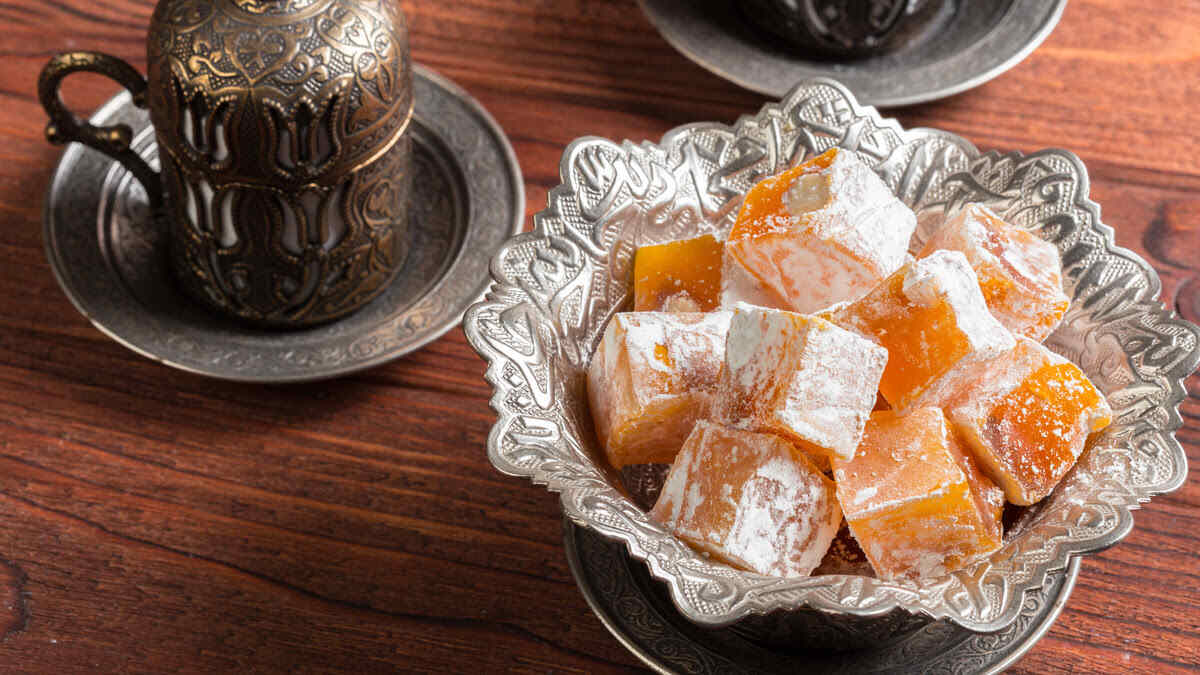Turkish delight, or Turkish jelly from the kitchen
Turkish delight, also known as lokum or rahat lokum, is one of the most recognizable sweets originating from Turkish tradition. These small, soft cubes with a delicate texture delight with a wealth of flavors and aromas—from classic rose water, through a mixture of nuts, to exotic fruit notes.
Sprinkled with delicate powdered sugar or coconut flakes, Turkish delight has for centuries won the hearts of sweet lovers around the world, becoming an inseparable symbol of Turkish confectionery art. Its history, dating back to the times of the Ottoman Empire, holds more than one curiosity worth discovering.
What is Turkish delight?
Turkish delight, in Poland also known as lokum or rahat lokum, is a true symbol of Turkish cuisine. It is hard to imagine a visit to Turkey without encountering this colorful sweet specialty, available in almost every local shop.
Lokum, present in Turkish tradition since the 15th century, is a type of soft jelly made from sugar and starch, enriched with natural aromas and colorings such as rose water, lemon, or pomegranate.
Literally translated, “rahat lokum” means “relief for the throat,” which perfectly reflects the delicate and velvety texture of this delicacy. In the past, Turkish delight was popular not only in the Ottoman Empire but also in Poland, Hungary, and Austria, where it was known as “Turkish bread.” An interesting fact is that the sweet cubes of lokum also played a role in literature— in “The Chronicles of Narnia,” it was they that became the tool used by the White Witch to entice Edmund. Today, Turkish delight impresses with a great variety of flavors and additions, and some regional varieties, such as the version with kaymak in Afyon, are true culinary rarities.
The history of Turkish delight
The origins of Turkish delight date back to the heyday of the Ottoman Empire, although the exact circumstances of the creation of this sweet have not been definitively established. Lokum, as Turkish delight is also called, is considered one of the oldest forms of dessert in the world. For centuries it has enchanted not only with its exquisite taste but also with its unique texture, becoming an important element of Turkish culinary culture.

The legend of Sultan Abdul Hamid I
One popular tale links the birth of lokum with the figure of Sultan Abdul Hamid I. According to the legend, this ruler, although not renowned as an outstanding strategist, perfectly understood the importance of pleasure in building relationships. To please his numerous wives and concubines, he ordered the court confectioners to create a dessert that would bring them comfort and joy. In response to his wish, a sweet with a soft texture was created, prepared from starch, sugar syrup, and additions such as nuts and dried fruit. The taste of Turkish delight proved so unique that it quickly became a permanent feature of palace feasts, and harmony reigned in the harem.
Bekir Effendi—the master who won the hearts of the Turks
Another version of the story points to Bekir Effendi, an outstanding confectioner from the mountainous region of Castamonu. In 1776 he came to Istanbul, where he opened a small sweet shop. Thanks to his creativity and excellent sense of taste, Bekir created a unique Turkish delight that quickly won the hearts of the city’s residents and attracted the attention of the sultan’s court. Interestingly, lokum wrapped in lace handkerchiefs became not only a favorite delicacy of many, but also a symbol of love, exchanged between lovers.
The flourishing of a family tradition
After the death of Bekir Effendi, the tradition was continued by his son, Mehmet Muhiddin, who made Turkish delight famous internationally, winning numerous awards in confectionery competitions. The next generation, represented by Ali Muhiddin, transformed the family business into a true sweet empire, opening shops not only in Turkey but also in Egypt. The brand Ali Muhiddin Hacı Bekir still operates today, and the historic shop in Istanbul, located near the New Mosque, continues to attract tourists and lovers of traditional Turkish flavors.
How is Turkish delight made?
The process of creating Turkish delight is based on the use of simple, natural ingredients, and at the same time requires great precision, a feel for temperature, and patience.
The base of this exceptional sweet is a mixture of starch—most often potato or wheat—and sugar. Both ingredients are carefully combined and cooked for a long time over low heat until the mixture achieves the proper thickness and clarity. Through slow thickening, a characteristic, springy gel is formed, which constitutes the foundation of this popular jelly.
Various ingredients are added to the mass to enrich the flavor and texture of the dessert. Traditional recipes often feature dates, pistachios, hazelnuts, or walnuts, which not only diversify the consistency but also give Turkish delight its unique character. The wealth of aromas is determined by natural flavorings—most commonly rose water, orange essence, fresh lemon juice, mint oil, or delicate spices such as cinnamon.
When the mass reaches the appropriate uniformity and aroma, it is poured into large, flat molds, where it cools and sets slowly. After achieving the proper consistency, the dessert is cut into small cubes of regular shape. To prevent sticking, each portion is coated in powdered sugar or coconut flakes, which also gives the sweets an attractive appearance. Thanks to its delicate, slightly gelatinous structure and subtly sweet taste, the finished Turkish delight pairs perfectly with intense Turkish coffee, which is why it often serves as an elegant finale to meals in Middle Eastern cuisines.
The most popular varieties of Turkish delight
Although classic Turkish delight is most associated with the delicate aroma of rose water, in reality there are many varieties of this Turkish sweet. It is the diversity of additions and preparation techniques that ensures everyone will find a version that perfectly suits their own preferences.
Among traditional flavors, the aforementioned rose water invariably reigns supreme, whose subtle sweetness and floral aroma are considered the quintessence of Turkish lokum. Lemon, orange, and mint variants are also popular, and thanks to their fresh notes they give the dessert lightness and refreshment. In more pronounced versions, you can find Turkish delight flavored with cinnamon, mastic (resin of the mastic tree), or even ginger.
In many regional varieties, lokum is enriched with additions in the form of nuts—most often pistachios, walnuts, or hazelnuts. Such combinations not only improve the taste but also give the dessert a pleasant texture. In Afyon, a renowned center of rahat lokum production, a special variety is popular in which kaymak, that is, thick cream from water buffalo milk, is placed between layers of gel, and the whole is sprinkled with coconut flakes.
Today, Turkish delight has also seen modern variants featuring exotic flavors such as pomegranate, mango, or passion fruit. The variety of forms and flavor compositions means that traditional lokum continues to gain new admirers both in Turkey and around the world.
Recipe for Turkish delight
Preparing Turkish delight at home is not the easiest task, but with a bit of patience you can achieve a result that rivals traditional products from Turkish confectioneries. Below is a recipe for about 30 cubes of lokum:
Ingredients:
- 800 g sugar,
- 1 tablespoon lime or lemon juice,
- 575 ml water,
- 120 g cornstarch,
- ¾ teaspoon citric acid,
- 300 ml blackcurrant, pomegranate, or other fruit juice,
- 160 g powdered sugar + extra for dusting,
- 30 g cornstarch for coating.
Preparation:
- In a large pot, combine the sugar, 375 ml water, and lemon juice. Heat over medium heat, stirring constantly, until the sugar is completely dissolved. When the syrup begins to boil, it is worth cleaning the sides of the pot of any sugar crystals to prevent recrystallization. Cook the mixture for about 30 minutes, stirring from time to time, until it reaches a temperature of about 130°C, then remove the pot from the heat.
- In a separate vessel, place 200 ml water, fruit juice, citric acid, and cornstarch. Heat the ingredients over low heat, stirring constantly with a whisk or mixer. The mass will thicken quickly, so constant stirring is crucial. When it reaches a very thick consistency, remove it from the heat and gradually add the previously prepared hot sugar syrup, mixing thoroughly each time.
- After combining the two masses, place the pot back over low heat and cook for another 1 hour and 20 minutes, stirring regularly to prevent the mixture from burning. After this time, the Turkish delight is ready to be transferred to a mold.
- Line a mold of about 20 × 20 cm with baking paper and lightly grease it. Pour the mass into the mold, level it, and set it aside for several hours to set completely—ideally leave it overnight.
- When the mass has set, prepare a coating mixture from powdered sugar and cornstarch. Sprinkle a thin layer of powdered sugar over the surface of the lokum, gently peel off the paper, and transfer the whole to a countertop also dusted with sugar. Then cut the mass into small cubes—preferably with a pizza cutter—and coat each one thoroughly in the prepared mixture.
- Store the finished Turkish delight in a closed container at room temperature, covered with an additional layer of powdered sugar with cornstarch to prevent sticking.
Turkish jellies from the kitchen | Summary
Although Turkish delight resembles the jellies we know, it captivates with a unique consistency and depth of flavor that is hard to find in other sweets. Interestingly, unlike many modern desserts, lokum does not contain gelatin—it owes its soft, springy structure to the traditional mixture of sugar and starch, not to ingredients of animal origin.

The rich history, variety of flavors, and elegant form make Turkish delight one of the most recognizable symbols of Turkish culinary culture. Regardless of whether we opt for the classic rose-flavored version or modern variations with exotic additions, lokum will always be a tasty bridge between the past and the present. It is worth succumbing to this sweet tradition and discovering Turkish delight on your own terms—whether during travel or in the comfort of your home kitchen.


